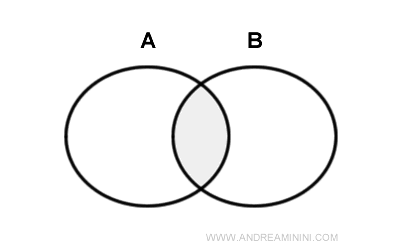Intersection of Set Interiors
The intersection of the interiors of two sets \(A\) and \(B\) is equal to the interior of the intersection of those sets $ \text{Int}(A \cap B) $ $$ \text{Int}(A) \cap \text{Int}(B) = \text{Int}(A \cap B) $$
In other words, the intersection of the interiors of two sets \(A\) and \(B\) is the same as the interior of their intersection.
To put it simply, if I take the points inside \(A\) and the points inside \(B\), and then find where these points overlap (i.e., take their intersection), I get exactly the points inside the set \(A \cap B\).
There are two key concepts to understand:
- Interior of a set (\(\text{Int}(A)\)): These are all the points in \(A\) that are not on the "edge" of the set. Each interior point has a small circle around it that is completely contained within \(A\).
- Intersection (\(\cap\)): This is the set of all points that belong to both \(A\) and \(B\).
So, if I take the interior points of \(A\) (\(\text{Int}(A)\)) and the interior points of \(B\) (\(\text{Int}(B)\)), and then find the intersection of these two sets of points, I get exactly the interior of the set \(A \cap B\).
A Practical Example
Imagine two circles \(A\) and \(B\) that partially overlap.
The interior of \(A\) is the entire area of \(A\) excluding its edge, and the same applies to \(B\).

If I take the intersection of these two interior areas, I get exactly the interior area of the region where \(A\) and \(B\) overlap.
The Proof
The proof is in two steps:
1] First Inclusion (\(\subseteq\))
If a point is inside set \(A\) and also inside set \(B\), then there is a small neighborhood around this point that is entirely within \(A\) and also entirely within \(B\).
Therefore, this neighborhood is also entirely within the intersection \(A \cap B\), which means the point is in the interior of \(A \cap B\).
Let \(x \in \text{Int}(A) \cap \text{Int}(B)\). Then \(x \in \text{Int}(A)\) and \(x \in \text{Int}(B)\).
By definition of interior, there exist two open neighborhoods \(U\) and \(V\) such that \(x \in U \subseteq A\) and \(x \in V \subseteq B\).
Consider the neighborhood \(W = U \cap V\). Since \(U\) and \(V\) are open, \(W\) is also open and contains \(x\).
Furthermore, \(W \subseteq A \cap B\), since \(W \subseteq U \subseteq A\) and \(W \subseteq V \subseteq B\).
Thus, \(x \in \text{Int}(A \cap B)\).
It follows that \(\text{Int}(A) \cap \text{Int}(B) \subseteq \text{Int}(A \cap B)\).
2] Second Inclusion (\(\supseteq\))
If a point is in the interior of \(A \cap B\), then there is a small neighborhood around this point that is entirely within \(A \cap B\).
Therefore, this neighborhood is also within set \(A\) and within set \(B\), which means the point is in the interior of both \(A\) and \(B\).
Let \(x \in \text{Int}(A \cap B)\). Then there exists an open neighborhood \(W\) of \(x\) such that \(W \subseteq A \cap B\).
Since \(W \subseteq A \cap B\), we have \(W \subseteq A\) and \(W \subseteq B\).
Therefore, \(x \in \text{Int}(A)\) and \(x \in \text{Int}(B)\).
It follows that \(x \in \text{Int}(A) \cap \text{Int}(B)\).
Thus, \(\text{Int}(A \cap B) \subseteq \text{Int}(A) \cap \text{Int}(B)\).
Since I have demonstrated both inclusions, I can conclude that the two sets are equal:
\[ \text{Int}(A) \cap \text{Int}(B) = \text{Int}(A \cap B) \]
The proof is complete.
And so forth.
